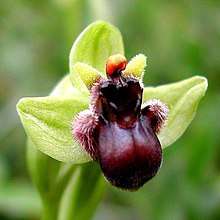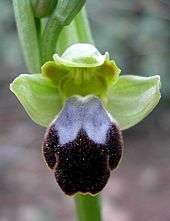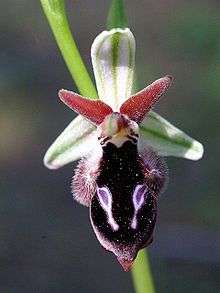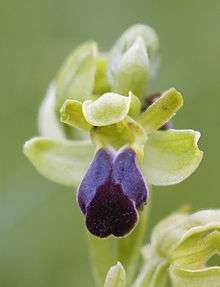Ophrys
The genus Ophrys is a large group of orchids from the alliance Orchis in the subtribe Orchidinae. They are widespread across much of Europe, North Africa, the Canary Islands, and the Middle East as far east as Turkmenistan.[2][3]
| Ophrys | |
|---|---|
 | |
| Bee Orchid (Ophrys apifera var. aurita) | |
| Scientific classification | |
| Kingdom: | Plantae |
| Clade: | Tracheophytes |
| Clade: | Angiosperms |
| Clade: | Monocots |
| Order: | Asparagales |
| Family: | Orchidaceae |
| Subfamily: | Orchidoideae |
| Tribe: | Orchideae |
| Subtribe: | Orchidinae |
| Genus: | Ophrys L., 1753 |
| Type species | |
| Ophrys insectifera[1] L., 1753 | |
| Synonyms[2] | |
| |
These plants are remarkable in that they successfully reproduce through pseudocopulation, that is, their flowers mimic female insects to such a degree that amorous males are fooled into mating with the flowers, thereby pollinating them. There are many natural hybrids.
They are referred to as the "bee orchids" due to the flowers of some species resemblance to the furry bodies of bees and other insects. Their scientific name Ophrys is the Greek word for "eyebrow", referring to the furry edges of the lips of several species.[4]
Ophrys was first mentioned in the book "Natural History" by Pliny the Elder (23-79 AD).
Biology
They are terrestrial or ground orchids from central to South Europe, North Africa, Asia Minor, up to the Caucasus Mountains, but mostly in the Mediterranean region. They have been said to be the most important group of European terrestrial orchids.[5]
During summer, all Ophrys orchids are dormant as underground bulbous tubers, which serve as a food reserve. In late summer/autumn they develop a rosette of leaves. Also a new tuber starts to grow and matures until the following spring; the old tuber slowly dies. The next spring the flowering stem starts to grow. During flowering the leaves have already started to wither.[4]
Most Ophrys orchids are dependent on symbiotic fungi. Transplanting specimens, especially wild specimens, is difficult, sometimes impossible, due to this symbiosis unless a large amount of surrounding earth is also taken with the plant. All orchids are protected under CITES II and should not be removed or disturbed in habitat.
The shiny, basal leaves have a green or bluish color. Two to twelve flowers grow on an erect stem with basal leaves.[5] These species are successfully cultivated by specialist growers of terrestrial orchids and are reported to be difficult to grow, being sensitive to rotting and damping off diseases if not properly subjected to a cool and dry aestivation period over the summer months with no water.[4]
Pollination
Orchids of the genus Ophrys use sexual deception to attract pollinators to their flowers.[6] In sexual deception, an orchid attracts male pollinators by producing the sex pheromone of virgin female pollinators in addition to providing visual and tactile cues (Schiestl 2005; Schluter et al. 2009; Stokl et al. 2009). These signals stimulate mating behavior in the male pollinators, which then attempt copulation, called “pseudocopulation”, with the orchid labellum (Schluter et al. 2009). During pseudocopulation, pollen from the flower's column becomes attached to some part of the pollinator, usually the head or abdomen, and the pollinator inadvertently carries and transfers this pollen to other flowers when they are once again enticed into pseudocopulation.[7][8][9] While the morphological cues such as the shape and texture of the labellum play a role especially at close range in inducing the pollinator mating behavior, the orchid's pheromone mimic, or allomone, has been shown to play the most important role in enticing pollinators to the flower (Schiestl 2005; Schluter et al. 2009).[5]
The allomone produced by an orchid is specific to its pollinator, of which it usually only has one (Ayasse et al. 2007; Gogler et al. 2009, Schluter et al. 2009). The allomone is a mixture of alkenes and alkanes (Schiestl and Cozzolino 2008). There are one or more active species in this mixture that account for the attraction of pollinators (Vereeken and Schiestl 2008). Pollinators and orchids use the same chemical compounds in the same absolute amounts in their pheromones and allomones, respectively (Schiestl 2008).
Every Ophrys orchid has its own pollinator insect and is completely dependent on this species for its survival. Duped males are less likely to return and may ignore other plants of the same species. Only about 10% of an Ophrys population gets pollinated. This is enough to preserve the population, since each Ophrys orchid produces about 12,000 minute seeds.[4]
Species
Almost 2,000 names have been proposed for species, subspecies, and "nothospecies" (i.e. species of hybrid origin) within the genus.[10] The number of species recognized varies very widely between authorities. Flora Europaea in 1980 and Pedersen & Faurholdt in 2007 listed about 20 species in Europe as a whole;[11][12] Buttler in 1991 increased this to 53 for slightly larger geographical area;[13] Delforge in 1995 gave a total of 130 species.[14] By contrast, a molecular phylogenetic study in 2008 suggested that there were around 10 distinguishable groups.[15]
The need for further study is indicated. For the moment (May 2014), we follow the lead of Kew Botanical Garden's, the World Checklist of Selected Plant Families in provisionally recognizing the following taxa:[10]
- Ophrys apifera Huds. – Bee orchid - Central and southern Europe, North Africa, east to Iran
- Ophrys × arachnitiformis Gren. & Philippe - False spider orchid (hybrid O. fuciflora × O. sphegodes) - western and central Europe from France and Britain to Sicily and Hungary
- Ophrys argolica H.Fleischm. – Argolian bee-orchid
- Ophrys argolica subsp. aegaea (Kalteisen & H. R. Reinhard) H. A. Pedersen & Faurh. - Greek islands
- Ophrys argolica subsp. argolica - Greece
- Ophrys argolica subsp. biscutella (O. Danesch & E. Danesch) Kreutz - southern Italy, Croatia
- Ophrys argolica subsp. crabronifera (Sebast. & Mauri) Faurh. - central and southern Italy
- Ophrys argolica subsp. elegans (Renz) E. Nelson - Cyprus
- Ophrys argolica subsp. lesbis (Gölz & H. R. Reinhard) H. A. Pedersen & Faurh. - western Turkey and the Greek Islands
- Ophrys argolica subsp. lucis (Kalteisen & H. R. Reinhard) H. A. Pedersen & Faurh. - Turkey, Syria, Greek islands
- Ophrys atlantica Munby – Atlantic Bee-orchid - Spain, Morocco, Algeria, Tunisia
- Ophrys bertolonii Moretti – Bertoloni's bee-orchid - from Spain to Serbia

- Ophrys bombyliflora Link – Bumblebee orchid - Mediterranean Basin and Canary Islands
- Ophrys cilicica Schltr. – Cilician bee-orchid - Turkey, Syria, Iran (note that Cilicia means southern Turkey)
- Ophrys ferrum-equinum Desf. – Horseshoe bee-orchid - Albania, Greece, Turkey
- Ophrys fuciflora (F.W.Schmidt) Moench – Late spider-orchid - from Britain to Iraq
- Ophrys fuciflora subsp. andria (P.Delforge) Faurh. - Greek islands
- Ophrys fuciflora subsp. apulica O.Danesch & E.Danesch - southern Italy including Sicily
- Ophrys fuciflora subsp. biancae (Tod.) Faurh. - Sicily
- Ophrys fuciflora subsp. bornmuelleri (M.Schulze) B.Willing & E.Willing - Turkey, Cyprus, Greek islands, Syria, Palestine, Israel, Iraq
- Ophrys fuciflora subsp. candica E.Nelson ex Soó - southern Italy including Sicily, plus Greece and Turkey
- Ophrys fuciflora subsp. chestermanii (J. J. Wood) H. Blatt & W. Wirth - Sardinia
- Ophrys fuciflora subsp. elatior (Paulus) R. Engel & Quentin Germany, Switzerland, France, Italy, Slovenia, Croatia
- Ophrys fuciflora subsp. fuciflora - from Britain to Syria
- Ophrys fuciflora subsp. grandiflora (H. Fleischm. & Soó) Faurh. - Turkey, Cyprus
- Ophrys fuciflora subsp. lacaitae (Lojac.) Soó - Italy, Malta, Croatia
- Ophrys fuciflora subsp. oblita (Kreutz, Gügel & W. Hahn) Faurh., H. A. Pedersen & S. G. Christ - Greece, Turkey, Lebanon, Syria, Palestine, Israel
- Ophrys fuciflora subsp. oxyrrhynchos (Tod.) Soó - southern Italy including Sicily
- Ophrys fuciflora subsp. pallidiconi Faurh. - Turkey
- Ophrys fuciflora subsp. parvimaculata O. Danesch & E. Danesch - Italy
- Ophrys fuciflora var. ziyaretiana (Kreutz & Ruedi Peter) Faurh. & H. A. Pedersen - Turkey, Lebanon, Syria, Palestine, Israel

- Ophrys fusca Link – Sombre bee-orchid, dark bee-orchid - from Portugal to Turkey
- Ophrys fusca subsp. blitopertha (Paulus & Gack) Faurh. & H.A.Pedersen - Turkey, Greek islands
- Ophrys fusca subsp. cinereophila (Paulus & Gack) Faurh.- Greece, Turkey, Cyprus, Lebanon, Syria
- Ophrys fusca subsp. fusca - from Portugal to Turkey
- Ophrys fusca subsp. iricolor (Desf.) K.Richt. - from Portugal to Turkey
- Ophrys fusca subsp. pallida (Raf.) E. G. Camus in E. G. Camus & A. A. Camus - Sicily, Tunisia, Algeria
- Ophrys insectifera L. – Fly orchid - much of Europe from Spain to Russia and Finland
- Ophrys insectifera nothosubsp. tytecaeana P. Delforge - France
- Ophrys insectifera subsp. aymoninii Breistr. France, Spain
- Ophrys insectifera subsp. insectifera - much of Europe from Spain to Russia and Finland
- Ophrys isaura Renz & Taubenheim - Turkey
- Ophrys kojurensis Gölz - Iran
- Ophrys konyana Kreutz & Ruedi Peter - Turkey
- Ophrys kopetdagensis K.P. Popov & Neshat. - Turkmenistan
- Ophrys kotschyi H. Fleischm. & Soó – Cyprus bee-orchid, Kotschy's bee-orchid - Greece, Cyprus
- Ophrys kotschyi subsp. ariadnae (Paulus) Faurh. - Greek islands and mainland
- Ophrys kotschyi subsp. cretica (Soó) H.Sund. - Crete and other Greek islands
- Ophrys kotschyi subsp. kotschyi – Cyprus
- Ophrys kreutzii W.Hahn - Turkey
- Ophrys lepida S. Moingeon & J.-M. Moingeon - Sardinia
- Ophrys lunulata Parl. - Sicily
.jpg)
- Ophrys lutea Cav. – Yellow bee-orchid - from Portugal and Morocco to Syria
- Ophrys lutea subsp. aspea (Devillers-Tersch. & Devillers) Faurh. - Tunisia, Libya
- Ophrys lutea subsp. galilaea (H. Fleischm. & Bornm.) Soó - from Portugal and Morocco to Syria
- Ophrys lutea subsp. lutea - from Portugal and Morocco to Turkey
- Ophrys lutea subsp. melena Renz - Greece, Albania
- Ophrys lycia Renz & Taubenheim - Turkey
- Ophrys omegaifera H. Fleischm. – Omega bee-orchid - from Portugal and Morocco to Syria
- Ophrys omegaifera var. basilissa (C. Alibertis, A. Alibertis & H.R. Reinhard) Faurh - Greece
- Ophrys omegaifera subsp. dyris (Maire) Del Prete - Spain, Portugal, Morocco, Balearic Islands
- Ophrys omegaifera subsp. fleischmannii (Hayek) Del Prete - Crete and other Greek islands
- Ophrys omegaifera subsp. hayekii (H. Fleischm. & Soó) Kreutz - Sicily, Algeria, Tunisia
- Ophrys omegaifera subsp. israelitica (H. Baumann & Künkele) G. Morschek & K. Morschek - Israel, Palestine, Lebanon, Syria, Turkey, Cyprus, Greece
- Ophrys omegaifera subsp. omegaifera - Turkey, Greek islands
- Ophrys omegaifera subsp. apollonae or Ophrys apollonae - Greek islands, Turkey
- Ophrys pseudomammosa Renz - Turkey, Greece

- Ophrys reinholdii Spruner ex Fleischm. – Reinhold's bee-orchid - from Croatia to Turkey
- Ophrys reinholdii subsp. antiochiana (H. Baumann & Künkele) H.Baumann & R.Lorenz - Turkey, Syria
- Ophrys reinholdii subsp. reinholdii - from Croatia to Turkey
- Ophrys reinholdii subsp. straussii (H. Fleischm.) E. Nelson - Iran, Iraq, Turkey, Cyprus, Greek islands
- Ophrys schulzei Bornm. & Fleischm. - Iran, Iraq, Turkey, Syria, Lebanon
- Ophrys scolopax Cav. – Woodcock bee-orchid - from Morocco and Portugal to Hungary and Iran
- Ophrys scolopax subsp. apiformis (Desf.) Maire & Weiller - Spain, Portugal, Sardinia, Sicily, Tunisia, Algeria, Morocco
- Ophrys scolopax subsp. conradiae (Melki & Deschâtres) H.Baumann & al. - Corsica, Sardinia, Italy
- Ophrys scolopax subsp. cornuta (Steven) E.G. Camus - Italy, Hungary, the Balkans, Crimea, Turkey, Caucasus
- Ophrys scolopax subsp. heldreichii (Schltr.) E.Nelson Greece, Turkey
- Ophrys scolopax var. minutula (Gölz & H.R. Reinhard) H.A. Pedersen & Faurh - Turkey, Greek islands
- Ophrys scolopax subsp. rhodia (H.Baumann & Künkele) H.A. Pedersen & Faurh. - Greek islands
- Ophrys scolopax subsp. scolopax - from Portugal to Iran
.jpg)
- Ophrys speculum Link – Mirror bee-orchid, mirror orchid - from Portugal to Syria
- Ophrys speculum subsp. lusitanica O.Danesch & E.Danesch - Spain, Portugal
- Ophrys speculum subsp. regis-ferdinandii (Acht. & Kellerer ex Renz) Soó - Turkey, Greek islands
- Ophrys speculum subsp. speculum - from Portugal to Syria
- Ophrys sphegodes Mill. – Early spider-orchid - from Britain and Portugal to Iran
- Ophrys sphegodes nothosubsp. jeanpertii (E.G. Camus) Del Prete & Conte - France, Spain, Balkans (O. sphegodes subsp. araneola × O. sphegodes subsp. sphegodes)
- Ophrys sphegodes subsp. aesculapii (Renz) Soó ex J.J.Wood - Greece
- Ophrys sphegodes subsp. araneola (Rchb.) M.Laínz - Germany, Switzerland, France, Spain, Italy, Yugoslavia
- Ophrys sphegodes subsp. atrata (Rchb.f.) A.Bolòs - from Portugal to Serbia
- Ophrys sphegodes subsp. aveyronensis J.J.Wood - France, Spain
- Ophrys sphegodes subsp. catalcana Kreutz - European Turkey
- Ophrys sphegodes subsp. cretensis H.Baumann & Künkele - Crete and other Greek islands
- Ophrys sphegodes subsp. epirotica (Renz) Gölz & H.R.Reinhard - Albania, Greece
- Ophrys sphegodes subsp. gortynia H.Baumann & Künkele - Crete and other Greek islands
- Ophrys sphegodes subsp. helenae (Renz) Soó & D.M.Moore - Albania, Greece
- Ophrys sphegodes subsp. mammosa (Desf.) Soó ex E.Nelson - from the Balkans to Turkmenistan
- Ophrys sphegodes subsp. passionis (Sennen) Sanz & Nuet - France, Spain, Sardinia, Sicily, mainland Italy
- Ophrys sphegodes subsp. sipontensis (R.Lorenz & Gembardt) H.A.Pedersen & Faurh. - Apulia
- Ophrys sphegodes subsp. sphegodes - from Britain and Spain to Hungary and the Balkans
- Ophrys sphegodes subsp. spruneri (Nyman) E.Nelson - Crete and other Greek islands
.jpg)
- Ophrys tenthredinifera Willd. - from Portugal and Morocco to Turkey
- Ophrys tremoris Gämperle & Gölz - Turkey
- Ophrys ulupinara W.Hahn - Turkey
- Ophrys umbilicata Desf. - from the Balkans to Iran
- Ophrys umbilicata subsp. beerii Shifman - Israel
- Ophrys umbilicata subsp. bucephala (Gölz & H.R.Reinhard) Biel - Turkey and the Greek islands
- Ophrys umbilicata subsp. calycadniensis Perschke - Turkey
- Ophrys umbilicata subsp. flavomarginata (Renz) Faurh. - Cyprus, Syria, Israel
- Ophrys umbilicata subsp. lapethica (Gölz & H.R.Reinhard) Faurh. - Cyprus
- Ophrys umbilicata subsp. latakiana (M.Schönfelder & H.Schönfelder) Faurh. & H.A.Pedersen - Turkey, Syria
- Ophrys umbilicata subsp. umbilicata - from the Balkans to Iran
- Ophrys urteae Paulus - Turkey
- Ophrys zagrica Gölz - Iran

In popular culture
Sexually deceptive orchids in the genus Ophrys feature in the 2002 movie, 'Adaptation', written by Charlie Kaufman. The film follows a screenwriter attempting to adapt the novel 'The Orchid Thief' into a movie screenplay. The species appearing in the movie may be Ophrys speculum.
The naturalist David Attenborough discusses the unusual pollination systems among Ophrys orchids in his 1995 BBC television series 'The Private Life of Plants', as well as the book accompanying the series.
References
- Jarvis, Taxon 41: 566 (1992)
- Kew World Checklist of Selected Plant Families
- Altervista Flora Italiana, Ophrys
- Pridgeon, Alec (1992). The Illustrated encyclopedia of orchids. Timber Press. ISBN 978-0-88192-267-7. OCLC 28182298.
- Dressler, Robert (1990). The orchids : natural history and classification. Harvard University Press. ISBN 978-0-674-87526-5. OCLC 21301257.
- Schiestl, F. P. (2005). "On the success of a swindle: pollination by deception in orchids" (PDF). Naturwissenschaften. 92 (6): 255–264. doi:10.1007/s00114-005-0636-y. PMID 15931514.
- Borg-Karlson, A.-K. (1990). "Chemical and ethological studies of pollination in the genus Ophrys (Orchidaceae)". Phytochemistry. 29 (5): 1359–1387. doi:10.1016/0031-9422(90)80086-v.
- Gögler, J.; Stökl, J.; Sramkova, A.; Twele, R.; Francke, W.; Cozzolino, S.; Cortis, P.; Scrugli, A.; Ayasse, M. (2009). "Ménage à Trois — Two Endemic Species of Deceptive Orchids and One Pollinator Species". Evolution. 63 (9): 2222–2234. doi:10.1111/j.1558-5646.2009.00712.x. PMID 19473395.
- Stokl, J.; Schluter, P. M.; Stuessy, T. F.; Paulus, H. F.; Fraberger, R.; Erdmann, D.; Schulz, C.; et al. (2009). "Speciation in sexually deceptive orchids: pollinator-driven selection maintains discrete odour phenotypes in hybridizing species". Biological Journal of the Linnean Society. 98 (2): 439–451. doi:10.1111/j.1095-8312.2009.01279.x.
- Search for "Ophrys", World Checklist of Selected Plant Families, Royal Botanic Gardens, Kew, retrieved 2012-03-29
- Tutin, T. G.; Heywood, V.H.; Burges, N.A.; Moore, D.M.; Valentine, D.H.; Walters, S.M. & Webb, D.A., eds. (1980), Flora Europaea, Vol. 5, Cambridge University Press, ISBN 978-0-521-20108-7
- Pedersen, H.Æ. & Faurholdt, N. (2007), Ophrys : The Bee Orchids of Europe, Richmond, Surrey, UK: Kew Publishing, ISBN 978-1-84246-152-5
- Buttler, Karl Peter (1991), Field Guide to Orchids of Britain and Europe, Swindon: Crowood, ISBN 978-1-85223-591-8
- Delforge, Pierre (1995), Orchids of Britain and Europe, transl. Christine Grey-Wilson, London: HarperCollins, ISBN 978-0-00-220024-0
- Devey, D. S.; Bateman, R.M.; Fay, M.F. & Hawkins, J.A. (2008), "Friends or Relatives? Phylogenetics and Species Delimitation in the Controversial European Orchid Genus Ophrys", Annals of Botany, 101 (3): 385–402, doi:10.1093/aob/mcm299, PMC 2701817, PMID 18184645
- Ayasse, Manfred (2007). "Chemical mimicry in sexually deceptive orchids of the genus Ophrys" (PDF). Phyton. 46 (2): 221–223.
- Schiestl, Florian P; Cozzolino, Salvatore (28 January 2008). "Evolution of sexual mimicry in the orchid subtribe orchidinae: the role of preadaptations in the attraction of male bees as pollinators". BMC Evolutionary Biology. Springer Nature. 8 (1): 27. doi:10.1186/1471-2148-8-27. ISSN 1471-2148. PMC 2267782. PMID 18226206.
- Schluter, P. M.; Ruas, P. M.; Kohl, G.; Ruas, C. F.; Stuessy, T. F.; Paulus, H. F. (2009). "Genetic patterns and pollination in Ophrys iricolor and O-mesaritica (Orchidaceae): sympatric evolution by pollinator shift". Botanical Journal of the Linnean Society. 159 (4): 583–598. doi:10.1111/j.1095-8339.2009.00957.x.
- Vereecken, N. J.; Schiestl, F. P. (2008). "The evolution of imperfect floral mimicry". Proceedings of the National Academy of Sciences of the United States of America. 105 (21): 7484–7488. doi:10.1073/pnas.0800194105. PMC 2396721. PMID 18508972.
External links
| Wikimedia Commons has media related to Ophrys. |